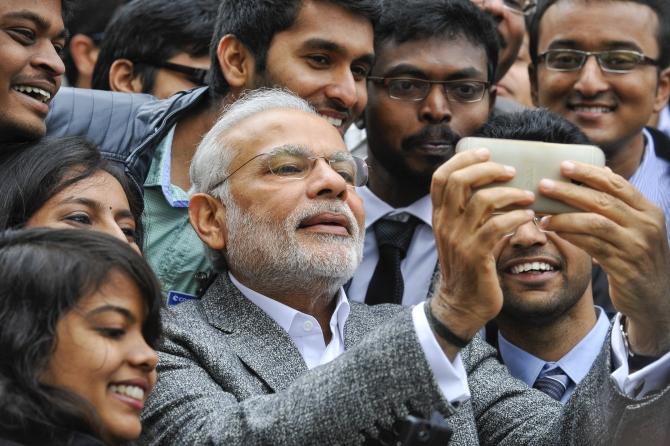 | « Back to article | Print this article |
The top five most mentioned Twitter accounts in tweets as on Thursday were those of Narendra Modi (@narendramodi) with 16,395 tweets, followed by @BJP4India (BJP's verified Twitter account) with 11,875, @RahulGandhi with 5,398, @INCIndia with 4,202 and @AmitShah with 3,496.

The mainstream social media war, going by Twitter trends, is between Prime Minister Narendra Modi and the principal Opposition party, the Congress.
The first of the seven phases of the Lok Sabha elections began on Thursday in 20 states. From the day before, social media was abuzz with hashtags and posts related to elections, voting, political preferences, etc.
The most used hashtags on Thursday on the microblogging platform Twitter were "#LokSabhaElections2019", "#ModiOnceMore", "#VoteForIndia", "#IndiaElections2019" and "#MyVoteForCongress", according to a study by the Indraprastha Institute of Information Technology, Delhi. The "#LokSabhaElections2019" was tweeted 40,800 times, "#ModiOnceMore" 26,491 times, "#VoteForIndia" 24,643 times, "#IndiaElections2019" 19,049 times, and "#MyVoteForCongress" 12,386 times.
Clearly, apart from the Lok Sabha election hashtags, only the ones about Modi and the Congress have a political connotation.
The top five most mentioned Twitter accounts in tweets as on Thursday were those of Narendra Modi (@narendramodi) with 16,395 tweets, followed by @BJP4India (BJP's verified Twitter account) with 11,875, @RahulGandhi with 5,398, @INCIndia with 4,202 and @AmitShah with 3,496.
On Instagram, which has an increasing political presence but is more a pictorial platform, the trends were different.
With younger people more active on the platform, 195 public images were tagged #firstvote, and another #inkfie -- or inked selfie -- was also popular.
Inked is a popular way to show a person voted, referring to the indelible ink on the index finger.
The research team analysed the Twitter data, comprising more than 200,000 tweets, using 123 hashtags from 3 am to 7 pm on April 11.
About 84 million first-time voters are expected to vote this time. In the first phase, several took to Twitter to announce their first-time vote.
The most popular first-time voter hashtags were #firsttimevoter (1,051 tweets), #MyFirstVoteForModi (3,676 tweets), #powerof18 (195 tweets), and #firstvote (93 tweets). The research found 3,348 unique users posting these tweets, and further analysis showed the occurrence of BJP, INC, Congress, Modi, Rahul, RaGa (Rahul Gandhi), and NaMo (Narendra Modi), along with one or more of these hashtags. It found Modi appearing 1,661 times and Gandhi appearing 984 times.
A day before the first phase of elections, the same team analysed the Twitter handles of Modi and Gandhi.
Modi’s account was created in January 2009, and Gandhi’s in April 2015. Modi is followed by 46.8 million accounts (as of writing this report) and follows 2,159 people, whereas Gandhi has 9.18 million followers and follows 207 people.
Further analysis of the Twitter data for both from January 1, 2018, to April 10 found Modi had 7.5 times more tweets than Gandhi. Modi’s tweets are re-tweeted three times and favourited 3.7 times more than Gandhi.
Twitter said on Thursday it recorded 45.6 million tweets related to the Lok Sabha elections between March 11, the day the elections were announced, and April 11, the first day of polling.
Political messaging through social media platforms has been a big theme in the current elections, with the Election Commission (EC) becoming strict about political advertising on these platforms.
Internet and social media companies, and the Internet and Mobile Association of India on March 20 agreed to present a voluntary code of ethics to the EC. Companies like Google, Twitter, Facebook (including WhatsApp), TikTok, WeChat, ShareChat and others will follow this code till the end of the elections.
However, numbers on mainstream platforms are only part of the social media story. While Twitter, Facebook, YouTube and Instagram continue have more obvious political content coming from political parties, regional content players like TikTok, ShareChat, LIKE and so on also have a measure of political content that is largely unregulated.
As political parties delved deeper into technology, they understood the importance of having reliable data on voter sentiment. Consequently, they are not just relying on digital data sets, but also on on-ground intelligence on what the voter wants.